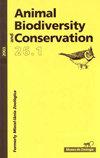Pathogens in anurans from a seasonal tropical environment in Guanajuato, Mexico
IF 1
4区 环境科学与生态学
Q3 BIODIVERSITY CONSERVATION
引用次数: 0
Abstract
In the present study, we characterized species of bacteria and fungi across a frog community in a seasonal tropical environment in the Natural Protected Area (NPA) Las Musas, Guanajuato, Mexico, using morphological and biochemical protocols. Our three main objectives were to: i) identify the species of microorganisms present in the frog community, ii) determine microorganism prevalence and how it changes throughout the year, and iii) detect diseases and injuries caused by pathogens (bacteria and fungi). Across 150 anurans analyzed, seven species of anurans especies (Anaxyrus compactilis, Incilius occidentalis, Dryophytes arenicolor, D. eximius, Hypopachus variolosus, Lithobates neovolcanicus y Spea multiplicata) hosted at least four genera of pathogenic fungi (Penicillium, Rhizopus, Aspergillus y Batrachochytrium) and two genera of pathogenic bacteria (Aeromonas hydrophila and Pseudomonas sp.). We found the prevalence of positive cases was higher in autumn (0.51) than in summer (0.125). Lesions such as peeling of the skin on the belly and swelling of the extremities (red leg) were observed in four of the seven species. This study confirms the presence of bacterial and fungal pathogenic agents in this frog community, and serves as a precedent for future work on monitoring the state of amphibian population health in Guanajuato. It also provides support for the implementation of conservation strategies for this group of vertebrates.墨西哥瓜纳华托季节性热带环境中anurans的病原体
在本研究中,我们使用形态学和生物化学方案,对墨西哥瓜纳华托Las Musas自然保护区(NPA)季节性热带环境中青蛙群落的细菌和真菌物种进行了表征。我们的三个主要目标是:i)确定青蛙群落中存在的微生物种类,ii)确定微生物流行率及其全年变化情况,以及iii)检测病原体(细菌和真菌)引起的疾病和伤害。在所分析的150例无尿症患者中,七种无尾类植物(Anaxyrus compactilis、Incilius occidentalis、Dryophytes arenicolor、D.eximius、Hypopachus variolosus、Lithobates neovanuracus和Spea multiplicata)至少有四个属的病原真菌(青霉属、根霉属、曲霉属和蝙蝠胡菌属)和两个属的致病菌(嗜水气单胞菌属和假单胞菌属)秋季(0.51)阳性率高于夏季(0.125)。7种中有4种出现腹部皮肤剥落和四肢肿胀(红腿)等病变。这项研究证实了该蛙群落中存在细菌和真菌病原体,并为未来监测瓜纳华托两栖动物种群健康状况的工作提供了先例。它还为这类脊椎动物的保护战略的实施提供了支持。
本文章由计算机程序翻译,如有差异,请以英文原文为准。
求助全文
约1分钟内获得全文
求助全文
来源期刊

Animal Biodiversity and Conservation
农林科学-动物学
CiteScore
2.00
自引率
0.00%
发文量
21
审稿时长
>12 weeks
期刊介绍:
Animal Biodiversity and Conservation (antes Miscel·lània Zoològica) es una revista interdisciplinar, publicada desde 1958 por el Museu de Ciències Naturals de Barcelona. Incluye artículos de investigación empírica y teórica en todas las áreas de la zoología (sistemática, taxonomía, morfología, biogeografía, ecología, etología, fisiología y genética) procedentes de todas las regiones del mundo. La revista presta especial interés a los estudios que planteen un problema nuevo o introduzcan un tema nuevo, con hipòtesis y prediccions claras, y a los trabajos que de una manera u otra tengan relevancia en la biología de la conservación. No se publicaran artículos puramente descriptivos, o artículos faunísticos o corológicos en los que se describa la distribución en el espacio o en el tiempo de los organismes zoológicos.
 求助内容:
求助内容: 应助结果提醒方式:
应助结果提醒方式:


